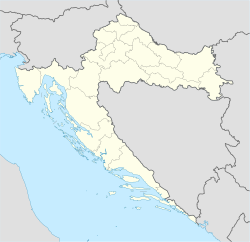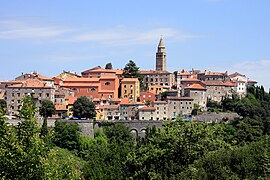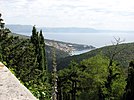world.wikisort.org - Croatia
Labin (Italian/Istriot: Albona) is a town in Istria, west Croatia, with a town population of 5,806 (2021) and 10,424 in the greater municipality (which also includes the small towns of Rabac and Vinež, as well as a number of smaller villages).[1]
Labin
Albona | |
|---|---|
Town | |
| Grad Labin Town of Labin | |
Labin | |
 Flag  Coat of arms | |
 Labin Location of Labin within Croatia | |
| Coordinates: 45°05′N 14°07′E | |
| Country | |
| County | |
| First mention (Artemidorus of Ephesus) | 2nd century BC |
| Government | |
| • Type | Mayor-Council |
| • Mayor | Valter Glavičić (IDS) |
| • City Council | 15 members |
| Area | |
| • Town | 72 km2 (28 sq mi) |
| Elevation | 210−320 m (689−1,050 ft) |
| Population (2021) | |
| • Town | 10,424 |
| • Density | 140/km2 (370/sq mi) |
| • Urban | 5,806 |
| Demonym(s) | Labinjonka (female) Labinjon (male) |
| Time zone | UTC+1 (CET) |
| • Summer (DST) | UTC+2 (CEST) |
| Postal code | 52220 |
| Area code | 052 |
| Vehicle registration | PU |
| Patron saints | St. Justus |
| Town day | August 19 |
| Website | www |
History

Labin developed from the site of the Roman settlement of Albona. Its name predates classical antiquity and is derived from Proto-Indo-European *alb- ("eminence", "hill").[2] Before and under the Roman occupation, Albona was an important commune. On a marble tablet the Roman inscription we read that under the Emperor Marco Iulio Severo Filippo noble Caesar noble Prince made Albona a Republic. To be a republic it had to have two joined Magistrates called Duumviri and Public officers called Aediles which took care of Public buildings and other official duties.[3]
From 1295 it was under the rule of the dukes of Pazin, and from 1381 it found itself under the jurisdiction of the Patriarchate of Aquileia. From 1420 until 1797 it was ruled from Venice and after that belonged to Austria. Labin, as a Croatian-speaking town, was for a long time the centre of Croatia's largest coal mining district, with four mines operating at the height of its production. In March and April 1921, the town was the scene of a miners' strike which quickly grew into an anti-fascist rebellion, considered to be the first of its kind, and the declaration of the short-lived Labin Republic .[4] The mine in downtown Labin closed in 1989. The large, coal-fired power plant in nearby Plomin now has its coal imported from outside sources once the mines were closed.
The famous Lutheran reformer Matthias Flacius Illyricus (3 March 1520 – 11 March 1575), was born in Labin and a small exhibition in what was once his house, commemorates this. Unfortunately, due to the counter-reformation, he was forced to live most of his life in exile in Germany where he became the undisputed leader of the conservative wing of the Lutheran movement after the death of Luther. His chief literary legacy was in the area of biblical exegesis.
Population
Settlements
The town's administrative area consists of 17 settlements:
- Bartići
- Breg
- Duga Luka
- Gondolići
- Gora Glušići
- Kapelica
- Kranjci
- Labin
- Marceljani
- Presika
- Rabac
- Ripenda Kosi
- Ripenda Kras
- Ripenda Verbanci
- Rogočana
- Salakovci
- Vinež
Demographics
| Year | Pop. | ±% |
|---|---|---|
| 1857 | 2,283 | — |
| 1869 | 2,698 | +18.2% |
| 1880 | 3,722 | +38.0% |
| 1890 | 4,231 | +13.7% |
| 1900 | 4,369 | +3.3% |
| 1910 | 4,564 | +4.5% |
| 1921 | 4,495 | −1.5% |
| 1931 | 3,531 | −21.4% |
| 1945[5] | 6,493 | +83.9% |
| 1948 | 7,958 | +22.6% |
| 1953 | 9,851 | +23.8% |
| 1961 | 10,253 | +4.1% |
| 1971 | 10,778 | +5.1% |
| 1981 | 12,014 | +11.5% |
| 1991 | 13,144 | +9.4% |
| 2001 | 12,426 | −5.5% |
| 2011 | 11,642 | −6.3% |
| 2021 | 10,424 | −10.5% |
| Source: Naselja i stanovništvo Republike Hrvatske 1857–2001, DZS, Zagreb, 2005 Source for year 1945: Cadastre National de l'Istrie, Jadranski institut Sušak, 1946. | ||
| population | 2283 | 2698 | 3722 | 4231 | 4369 | 4564 | 4495 | 3531 | 7958 | 9851 | 10253 | 10778 | 12014 | 13144 | 12426 | 11642 | 10424 |
| 1857 | 1869 | 1880 | 1890 | 1900 | 1910 | 1921 | 1931 | 1948 | 1953 | 1961 | 1971 | 1981 | 1991 | 2001 | 2011 | 2021 |
Climate
Culture
Language
Labinjonska Cakavica, one of the most interesting and oldest Istrian dialects spoken in and around the town of Labin. It belongs to Northern Chakavian dialect of the Chakavian variety of Croatian. It differs from the usual Chakavian (with typical pronoun "ča") because it lacks most palatals, with other parallel deviations called "tsakavism" (cakavizam). In 2019, by the decision of the Ministry of Culture, Labinjonska Cakavica became a protected intangible cultural asset of the Republic of Croatia.[9]
Sport
The city is the home of football club NK Rudar Labin, and handball clubs ŽRK Rudar Labin and RK Mladi Rudar Labin.
Administration and politics
Mayor
The current mayor of Labin is Valter Glavičić (IDS), elected in the 2021 Labin local elections which were held on 16 May 2021. There is one deputy mayor elected from the same list, Federika Mohorović Čekada.[10]
Municipal Council
The Labin Council is composed of 15 representatives, elected in the 2021 Labin local elections.
The political groups represented in the Council (as of June 2021):
| Groups | No. of members per group |
|---|---|
| 2021 | |
| IDS, ISU | 9 / 15 |
| Democrats | 2 / 15 |
| SDP | 2 / 15 |
| Independents together | 1 / 15 |
| HDZ | 1 / 15 |
| Source:[11] | |
Councils of Local Committees
In 2020, elections were held for the councils of all seven local committees of the City of Labin.[12]
| Groups | No. of members per group |
|---|---|
| 2020 | |
| IDS | 31 / 39 |
| SDP | 7 / 39 |
| MOST | 1 / 39 |
| Source:[12] | |
International relations
Twin towns – sister cities[13]
 Idrija, Slovenia
Idrija, Slovenia
Partnerships[13]
See also
- Labinština
- Istria (peninsula)
- Istria County
- Labin Republic
References
- "Census of Population, Households and Dwellings in 2021 - Population by Settlements". Croatian Bureau of Statistics. 22 September 2022. Retrieved 27 September 2022.
- Šimunović 2013, pp. 167–168.
- Labin, Yugoslavia (1870). Societa del Gabinetto di Minerva (ed.). Statuto municipale della città di Albona dell'a. 1341 (in Italian). Trieste: Società del Gabinetto di Minerva. pp. III–XVI. Retrieved 19 December 2013.
- G. Scotti - L. Giuricin. La Repubblica di Albona e il movimento dell'occupazione delle fabbriche in Italia
- "Cadastre National de l'Istrie". Jadranski institut Sušak. July 1946.
- "POPULATION BY RELIGION, BY TOWNS/MUNICIPALITIES, 2021 CENSUS". Državni zavod za statistiku. September 2022.
- "POPULATION BY ETHNICITY, BY TOWNS/MUNICIPALITIES, 2021 CENSUS". Državni zavod za statistiku. September 2022.
- "Cadastre National de l'Istrie". Jadranski institut Sušak. July 1946.
- ""Labinjonska cakavica zaštićeno nematerijalno kulturno dobro"". HRT Magazin. 2019. Retrieved 1 May 2022.
- "Federika Mohorović Čekada kandidatkinja IDS-a za zamjenicu gradonačelnika Labina". Labiska Komuna.
{{cite web}}: CS1 maint: url-status (link) - "Konstituirano Gradsko vijeće, predsjednica Eni Modrušan". Grad labin.
{{cite web}}: CS1 maint: url-status (link) - "Izbori za članove vijeća mjesnih odbora Grada Labina". Grad Labin.
{{cite web}}: CS1 maint: url-status (link) - "Međunarodna suradnja". Grad Labin.
Sources
- Šimunović, Petar (March 2013). "Predantički toponimi u današnjoj (i povijesnoj) Hrvatskoj" [Pre-Roman placenames in present-day (and historical) Croatia] (PDF). Folia Onomastica Croatica (in Croatian). Zagreb: Croatian Academy of Sciences and Arts (22): 147–214. Retrieved 18 January 2016.
External links
- Official website (in Croatian)
- Labin.com is the first site about Labin (in Croatian)
- Labin.biz - search engine for small businesses registered in Labin (in Croatian)
На других языках
[de] Labin
Labin (italienisch Albona, lateinisch Albona) ist eine Stadt in der Gespanschaft Istrien, Kroatien. Labin liegt nahe der Ostküste der istrischen Halbinsel auf halber Strecke zwischen Pula und Opatija. Die Gemeinde hat fast 12.000 Einwohner, von denen rund 6.900 in der Kernstadt und 1.400 in dem Fremdenverkehrsort Rabac (Portalbona) wohnen.- [en] Labin
[ru] Лабин
Ла́бин (хорв. Labin, итал. Albona) — город в Хорватии, в восточной части полуострова Истрия. Население — 11 642 человека (по данным переписи 2011[1]).Другой контент может иметь иную лицензию. Перед использованием материалов сайта WikiSort.org внимательно изучите правила лицензирования конкретных элементов наполнения сайта.
WikiSort.org - проект по пересортировке и дополнению контента Википедии




